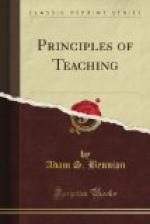“There are several things to be considered before presenting the lesson on the Resurrection to little children.
“First, the teacher must feel that she can present it. In other words, she must love the story and feel the importance of it. She must also be able to see the beautiful side and remember that she is teaching, ’There is no death; but life eternal.’
“The next question to consider is: How are we going to present it? We must lead the child from the known to the unknown, through the child’s own experience. Therefore we go to nature, because all nature appeals to the child. But in order to create the right atmosphere, the teacher in selecting the subject must feel that what he has selected is the very thing he wants in order to explain to the child, ‘There is no death.’
“There are several ways in which the subject may be approached through nature. We may take the Autumn and let the children tell what happens to the trees, flowers, and different plants. Lead them to see the condition after the leaves are off. Then what will happen next Spring. Or we may take one specific tree or brush and talk of the twig where the leaves were in the summer, but have now fallen to the ground. The twig looks dead. But on opening the bud and removing the brown covering we find the tiny leaf inside waiting and preparing to come forth in the Spring.
“The bulb may be used in a similar way, leading the child to see the bulb as it is before planting, then to see what happens when we plant it.
“The caterpillar may also be used. Here we have the live worm getting ready to go into his cocoon and is absent for some time; then he returns, only in another form. A higher stage.
“Lead the child to see that every thing in nature has a period of changing, of apparently going away for a short time, but is not dead—it returns to life.
“Be sure to have the objects you are talking about before the class, while you are discussing the subject. If not obtainable, use a picture, or draw them.”
The problem of the story of Jonah is usually submitted with a twinkle in the eye of him who raises the question. The world has so generally relegated it to the heap of the impossible that even some of our own people look rather amazed when a champion for Jonah steps forward. And yet this story properly approached is one of the teacher’s greatest opportunities. If it is to be presented to small children it can be told very beautifully, either as a lesson on disobedience or, from the point of view of the people of Nineveh, as a lesson on fasting and prayer. Little children will not be troubled with doubt and disbelief unless the teacher fosters such attitudes.
To older minds, of course, the story already is a good bit of a stumbling block, and therefore needs to be given thoughtful preparation.
At the outset, with older students, we ought to lead them into the beauties of the story—beauties which all too frequently are wholly unknown to the ordinary boy or girl. Read the story:




